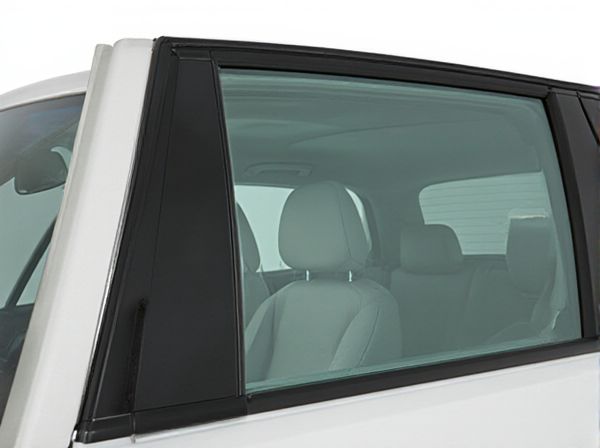
Photo illustration: Heated Glass vs Unheated Glass
Heated glass provides improved thermal insulation and prevents condensation, making it ideal for colder climates and energy-efficient buildings. Unheated glass is more cost-effective but may lead to heat loss and fogging in certain conditions. Choosing the right option depends on your specific needs for comfort and energy savings.
Table of Comparison
| Feature | Heated Glass | Unheated Glass |
|---|---|---|
| Defrosting | Quickly removes ice and fog using embedded heating elements | Relies on external heat sources; slower defrosting and demisting |
| Visibility | Improves driver visibility in cold and humid conditions | Visibility can be reduced by frost and condensation |
| Energy Consumption | Requires electrical power from the car's battery | No energy consumption |
| Cost | Higher initial purchase and installation cost | Lower cost; standard option |
| Durability | Durable but may require repairs if heating elements fail | Less complex; minimal maintenance |
| Climate Suitability | Ideal for cold, icy, and humid regions | Suitable for mild climates |
Introduction to Heated and Unheated Glass
Heated glass incorporates embedded heating elements or films that actively regulate surface temperature, preventing condensation and improving thermal comfort in environments like automotive windshields and smart windows. Unheated glass functions as a passive barrier, relying solely on ambient conditions to maintain temperature, which can lead to fogging or frost in cold environments. The choice between heated and unheated glass directly affects energy efficiency, visibility, and safety in applications where temperature control is critical.
How Heated Glass Technology Works
Heated glass technology integrates transparent conductive coatings or embedded wires that generate heat when an electric current passes through, preventing condensation and ice buildup on the surface. This system utilizes conductive materials such as tin oxide or silver nanoparticles, allowing uniform heat distribution across the glass. Unlike unheated glass, which only insulates passively, heated glass actively maintains transparency and thermal comfort by transforming electrical energy into radiant heat.
Key Benefits of Heated Glass
Heated glass offers superior thermal insulation by actively regulating surface temperature, reducing condensation and frost buildup in cold environments. It enhances energy efficiency by maintaining consistent indoor temperatures, which lowers heating costs compared to unheated glass. Safety is improved as heated glass minimizes the risk of shattering due to temperature fluctuations, making it ideal for both residential and commercial applications.
Advantages of Unheated Glass Applications
Unheated glass offers superior optical clarity and energy efficiency in applications where natural light transmission is critical, such as in architectural windows and display cases. It avoids the potential distortions and energy consumption associated with heated glass systems, reducing operational costs and maintenance requirements. Unheated glass also provides enhanced durability and resistance to thermal stress in environments with stable temperature conditions.
Thermal Performance Comparison
Heated glass significantly outperforms unheated glass in thermal performance by actively generating heat to maintain surface temperature, preventing condensation and frost buildup. Unheated glass relies solely on passive insulation properties, resulting in lower thermal efficiency and increased heat loss through conduction and convection. The integration of transparent conductive coatings or embedded heating elements in heated glass enhances energy efficiency by providing targeted warmth and reducing reliance on external heating systems.
Energy Efficiency: Heated vs Unheated Glass
Heated glass offers superior energy efficiency by actively reducing heat loss through built-in heating elements that maintain surface temperature, thereby minimizing reliance on external heating systems. In contrast, unheated glass allows greater thermal transfer, resulting in higher energy consumption to maintain indoor comfort. Utilizing heated glass can significantly lower energy bills and improve insulation performance in both residential and commercial buildings.
Safety and Durability Considerations
Heated glass offers enhanced safety by reducing the risk of condensation and frost buildup, which improves visibility and minimizes accidents in cold environments. Its durability surpasses unheated glass through integrated heating elements that prevent stress fractures caused by rapid temperature changes. Unheated glass, while more cost-effective, is more prone to cracking and breakage under thermal stress, making it less reliable in harsh weather conditions.
Aesthetic and Design Differences
Heated glass features embedded transparent heating elements that maintain a sleek, modern appearance without visible hardware, enhancing minimalist and contemporary design aesthetics. Unheated glass relies on traditional insulation methods, often requiring bulkier framing or external heating devices that can disrupt clean lines and design cohesion. The seamless integration of heated glass allows architects and designers to achieve visually uninterrupted surfaces while offering enhanced functionality.
Cost Analysis: Upfront and Long-Term
Heated glass typically incurs a higher upfront cost due to integrated heating elements and advanced manufacturing processes compared to unheated glass, which is more affordable initially. Long-term expenses for heated glass include increased energy consumption for maintaining temperature, but this can be offset by improved comfort and reduced reliance on external heating systems, potentially lowering overall heating costs. Unheated glass requires additional insulation or heating solutions, leading to higher cumulative expenses over time despite its lower initial price.
Choosing the Right Glass for Your Needs
Heated glass offers enhanced thermal insulation and reduces condensation, making it ideal for colder climates or energy-efficient buildings. Unheated glass, while more affordable, is suitable for standard applications where temperature control is less critical. Selecting the right glass depends on balancing budget, insulation requirements, and specific environmental conditions.
 caratoz.com
caratoz.com